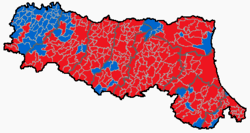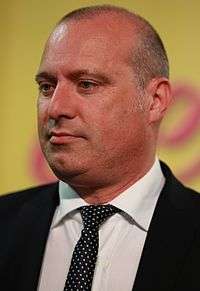Politics of Emilia-Romagna
 |
|---|
| This article is part of a series on the politics and government of Emilia-Romagna |
|
The Politics of Emilia-Romagna, Italy takes place in a framework of a presidential representative democracy, whereby the President of Regional Government is the head of government, and of a pluriform multi-party system. Executive power is exercised by the Regional Government. Legislative power is vested in both the government and the Legislative Assembly.
Executive branch
The Regional Government (Giunta Regionale) is presided by the President of the Region (Presidente della Regione), who is elected for a five-year term, and is composed by the President, the Ministers (Assessori), who are currently 12, including a Vice President and one Under-Secretary for in President's office.[1]
List of Presidents
| # | President | Term of office | Party | Legislature | ||
|---|---|---|---|---|---|---|
| 1 | Guido Fanti | 28 July 1970 | 22 July 1975 | PCI | Legislature I (1970–1975) | |
| 22 July 1975 | 21 May 1976 | Legislature II (1975–1980) | ||||
| 2 | Sergio Cavina | 21 May 1976 | 22 December 1977 | PCI | ||
| 3 | Lanfranco Turci | 22 December 1977 | 25 July 1980 | PCI | ||
| 25 July 1980 | 16 July 1985 | Legislature III (1980–1985) | ||||
| 16 July 1985 | 28 April 1987 | Legislature IV (1985–1990) | ||||
| 4 | Luciano Guerzoni | 28 April 1987 | 24 June 1990 | PCI | ||
| 5 | Enrico Boselli | 24 June 1990 | 5 July 1993 | PSI | Legislature V (1990–1995) | |
| 6 | Pier Luigi Bersani | 5 July 1993 | 9 June 1995 | PDS | ||
| 9 June 1995 | 28 May 1996 | Legislature VI (1995–2000) | ||||
| 7 | Antonio La Forgia | 5 June 1996 | 22 February 1999 | PDS | ||
| 8 | Vasco Errani | 3 March 1999 | 16 April 2000 | DS | ||
| 16 April 2000 | 5 April 2005 | Legislature VII (2000–2005) | ||||
| 5 April 2005 | 29 March 2010 | PD | Legislature VIII (2005–2010) | |||
| 29 March 2010 | 8 July 2014 | Legislature IX (2010–2014) | ||||
| 9 | Stefano Bonaccini | 24 November 2014 | present | PD | Legislature X (2014–present) | |
Legislative branch
The Legislative Assembly of Emilia-Romagna (Assemblea Legislativa dell'Emilia-Romagna) is composed of 50 members. 40 councillors are elected in provincial constituencies by proportional representation using the largest remainder method with a Droop quota and open lists, while 10 councillors (elected in bloc) come from a "regional list", including the President-elect. One seat is reserved for the candidate who comes second. If a coalition wins more than 50% of the total seats in the Council with PR, only 5 candidates from the regional list will be chosen and the number of those elected in provincial constituencies will be 45. If the winning coalition receives less than 40% of votes special seats are added to the Council to ensure a large majority for the President's coalition.[2]
The Council is elected for a five-year term, but, if the President suffers a vote of no confidence, resigns or dies, under the simul stabunt, simul cadent clause introduced in 1999 (literally they will stand together or they will fall together), also the Council is dissolved and a snap election is called.[3]
Parties and elections
Latest regional election
In the latest regional election, which took place on 23 November 2014, Stefano Bonaccini (Democratic Party) was elected President of Emilia-Romagna. The election marked the first time in which a President was elected with less than 50% of the vote.
|
| |||||||||||||||||||||||||||||||||||||
| |||||||||||||||||||||||||||||||||||||
All 50 seats to the Regional Council of Emilia-Romagna | |||||||||||||||||||||||||||||||||||||
|---|---|---|---|---|---|---|---|---|---|---|---|---|---|---|---|---|---|---|---|---|---|---|---|---|---|---|---|---|---|---|---|---|---|---|---|---|---|
| |||||||||||||||||||||||||||||||||||||
 Regional election results map. Red denotes provinces with a Democratic plurality, Blue denotes those with a Centre-right plurality. | |||||||||||||||||||||||||||||||||||||
| |||||||||||||||||||||||||||||||||||||
The Emilia-Romagna regional election of 2014 took place on 23 November 2014.
The three-term incumbent President of the Region, Vasco Errani of the centre-left Democratic Party resigned in July 2014 after the conviction for fraudulent misrepresentation,[4] triggering a snap election.
In an election marked by the lowest turnout ever in the Region (37.7%), Stefano Bonaccini, a Democrat, was elected President by defeating several candidates, mainly Alan Fabbri of Lega Nord Emilia (29.9%) and Giulia Gibertoni of the Five Star Movement (13.3%).
Electoral Law
The Legislative Assembly of Emilia-Romagna (Assemblea Legislativa dell'Emilia-Romagna) is composed of 50 members. 40 councillors are elected in provincial constituencies by proportional representation using the largest remainder method with a Droop quota and open lists, while 10 councillors (elected in bloc) come from a "regional list", including the President-elect. One seat is reserved for the candidate who comes second. If a coalition wins more than 50% of the total seats in the Council with PR, only 5 candidates from the regional list will be chosen and the number of those elected in provincial constituencies will be 45. If the winning coalition receives less than 40% of votes special seats are added to the Council to ensure a large majority for the President's coalition.[5]
Parties and leaders
| Political force or alliance | Constituent lists | Leader | ||
|---|---|---|---|---|
| Democratic Party | ||||
| Left Ecology Freedom | ||||
| Civic Emilia-Romagna (SC–PSI–Greens) | ||||
| Centre for Bonaccini (CD–Demo.S) | ||||
| Lega Nord Emilia–Romagna | ||||
| Forza Italia | ||||
| Brothers of Italy | ||||
| Five Star Movement | ||||
| The Other Emilia-Romagna (PRC–PdCI) | ||||
| Popular Emilia-Romagna | ||||
| Free Citizens for Emilia-Romagna | ||||
Results
 | |||||||||
| Candidates | Votes | % | Seats | Parties | Votes | % | Seats | ||
|---|---|---|---|---|---|---|---|---|---|
| Stefano Bonaccini | 615,723 | 49.05 | 1 | ||||||
| Democratic Party | 535,109 | 44.52 | 29 | ||||||
| Left Ecology Freedom | 38,845 | 3.23 | 2 | ||||||
| Civic Emilia-Romagna (SC–PSI–Greens) | 17,984 | 1.49 | – | ||||||
| Centre for Bonaccini (CD–Demo.S–IdV) | 5,247 | 0.43 | – | ||||||
| Total | 597,185 | 49.69 | 31 | ||||||
| Alan Fabbri | 374,736 | 29.855 | 1 | ||||||
| Lega Nord Emilia–Romagna | 233,439 | 19.42 | 8 | ||||||
| Forza Italia | 100,478 | 8.36 | 2 | ||||||
| Brothers of Italy | 23,052 | 1.91 | 1 | ||||||
| Total | 356,969 | 29.70 | 11 | ||||||
| Giulia Gibertoni | 167,022 | 13.30 | – | Five Star Movement | 159,456 | 13.26 | 5 | ||
| Maria Cristina Quintavalla | 50,211 | 4.00 | – | The Other Emilia-Romagna (PRC–PdCI) | 44,676 | 3.71 | 1 | ||
| Alessandro Rondoni | 33,437 | 2.66 | – | Popular Emilia-Romagna | 31,635 | 2.63 | – | ||
| Maurizio Mazzanti | 14,129 | 1.12 | – | Free Citizens for Emilia-Romagna | 11,864 | 0.98 | – | ||
| Total candidates | 1,255,258 | 100.00 | 2 | Total parties | 1,201,785 | 100.00 | 48 | ||
| Source: Ministry of the Interior – Historical Archive of Elections | |||||||||
References
- ↑ Giunta - ERMES Regione Emilia-Romagna Archived 13 November 2008 at the Wayback Machine.
- ↑ La Repubblica – Regional electoral law
- ↑ Regional Council of Lombardy – 1999 Constitutional law
- ↑ Errani condannato a un anno per falso, il presidente della Regione si dimette
- ↑ La Repubblica – Regional electoral law


